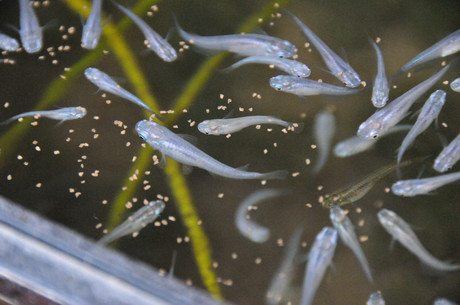Fish in space: a study in gravitational biology

Life in a reduced-gravity environment can have lasting problems on the body, with astronauts undergoing a significant drop in bone mineral density during space missions. Unfortunately, the precise molecular mechanisms responsible for such changes in bone structure are not yet clear.
Seeking to understand these molecular mechanisms, researchers from Tokyo Institute of Technology sent tiny Japanese rice fish — also known as medaka — to the International Space Station (ISS), where they were exposed to microgravity. Performing real-time imaging on the fish, the researchers witnessed the emission of fluorescent signals derived from the fishes’ osteoblasts (cells that synthesise bone) and osteoclasts (cells that break down bone tissue). The results were published in the journal Scientific Reports.
The researchers’ imaging of osteoblasts showed the intensity of osterix- and osteocalcin-DsRed in pharyngeal bones to increase one day after launch. This increased effect continued for eight days for osterix and five days for osteocalcin. In the case of osteoclasts, the fluorescent signals observed from TRAP-GFP and MMP9-DsRed increased significantly on the fourth and sixth days after launch.
Working from the Tsukuba Space Center in Japan, the team used four different double medaka transgenic lines focusing on upregulation of fluorescent signals of osteoblasts and osteoclasts, and also studied changes in the gene expression in the transgenic fish by transcriptome analysis. They observed increases in both osteoblast and osteoclast specific promoter-driven GFP and DsRed signals one day after launch, which continued for up to eight days.
“HiSeq from pharyngeal bones of juvenile fish at day 2 after launch showed upregulation of 2 osteoblast- and 3 osteoclast-related genes,” the researchers wrote. Transcription of the ‘nucleus’ was enhanced based on whole body gene ontology analysis of RNA-Seq, with the researchers observing transcription-regulators to be more upregulated at day 2 compared with during day 6. Finally, the team identified five genes that were all upregulated in the whole body on days 2 and 6, and in the pharyngeal bone on day 2.

The study serves as a major step towards uncovering the mechanisms governing changes in bone structure immediately after the onset of microgravity, when bone loss is triggered, with the researchers stating that exposure to microgravity induced an immediate “dynamic alteration of gene expressions in osteoblasts and osteoclasts”. In their next experiment, the colleagues will clarify the role of glucocorticoid receptor (GR) on cells in microgravity.
Revealed: the complex composition of Sydney's beach blobs
Scientists have made significant progress in understanding the composition of the mysterious...
Sensitive gas measurement with a new spectroscopy technique
'Free-form dual-comb spectroscopy' offers a faster, more flexible and more sensitive way...
The chemistry of Sydney's 'tar balls' explained
The arrival of hundreds of tar balls — dark, spherical, sticky blobs formed from weathered...




